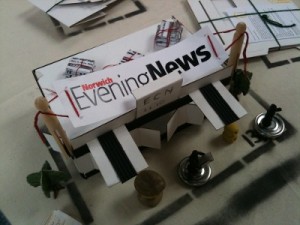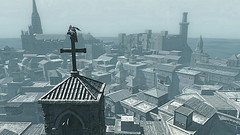A blog post is the wrong shape for pulling together strands from The Story. The day was enormously disparate – so many tales – but there were common strands that tied talks together across disciplines and across wildly varying conceptions of narrative and of story.
Listen. Because listening generously creates an articulate speaker. Moments in Karl James’s deeply moving talk stuck out for me like sore thumbs: I am not a journalist, he said, and therefore I get a better story. I can ask more questions. How do my questions differ from what journalists ask?
As a journalist, I’ve interviewed hundreds of people. Always you try to listen, but always you have the shape of the story to contend with. Literally, in some cases, for print: the story is a certain shape, a certain length and width and height with a certain size and shape of picture that goes with it; the form is constrained and constraining, and the questions you ask end up being designed to elicit answers that fit in and with the space you have available. The story gets chopped up into pieces, and the parts that fit become canonical while the rest are left as fragments that do not get retold. Good journalism is surgery.
Fragments. The idea that stories are falling apart, narratives disintegrating into small pieces that carry meaning by themselves but that are no longer embedded into larger story structures. And that by escaping from stable structures these fragments become building blocks, “accreting like coral” (to borrow @glinner’s phrase) and forming new, more serendipitous narratives.
This is a problem I’ve been running up against in journalism since I started journalisting – stories that in former times could be pinned to the page or confined to the lead slot on the evening bulletin can’t be, any more. They twist and turn and escape their boundaries. There is always more that can be said, context to the content the curators choose – like the video Adam Curtis showed of an interview in Helmand, where, once you reached outside the shape the story had to fit, you found an even more fascinating narrative, that fascinated more because it didn’t make sense – because it felt real, because it wasn’t neat or tidy or enclosed. Grand narratives are disintegrating, being questioned and contextualised in unexpected ways by the people formerly known as the audience.
Some speakers at The Story – Phil Gyford, Lucy Kimbell – are tackling this head-on in fields that aren’t (necessarily) newsgathering. Journalists should be talking to other storytellers, because all sorts of people are dealing with this fragmentation of narrative and they’re doing it innovatively and creatively and we are idiots if we are not looking for the links and the lessons between news storytelling and other creative practices.
Because the coral accretions of those fragments become things like The IT Crowd, or Cornelia Parker‘s objects that carry huge cultural significance despite being divorced from their original contexts. Like atoms in the ether, stories bubble into existence and coalesce whether there is anyone there to “read” them or not; like our host Margaret Robertson’s declaration that our clothes tell stories about ourselves; like @kcorrick’s Sole of The Story. Like conference notes that become art objects and accrue their own stories. And like LARPers frothing about zombies and turning fragments of experience into solid narratives, curating the experience themselves.
And because stories are still hugely powerful, and not always benign. Jane, in Karl James’s Dialogue Project, warns against becoming your story, when that story is damaging or damaged. Mark Stevenson recasts the metanarrative of global disaster into a story about how everything is getting better, really. Matt Adams uses text messages to tell stories with teenagers, in an attempt to shape a world where they are more informed and more aware of difficulties facing them. Cultures tell grand stories to themselves, to define themselves, and a grand story can shape as well as define.
This blog post doesn’t have a beginning or a middle, and it isn’t really going to have an end. I’m rewiring my brain to cope with new concepts – I genuinely feel like several speakers yesterday took the top of my head off and I am still finding unexpected cogs in peculiar places and gluing the results back together. There will be more, I am certain.
[edited to add link to Antony Mayfield’s summary of Adam Curtis’s talk]





